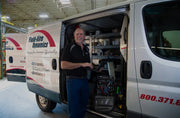Custom Compressed Air Services for Woodworking Professionals
Fluid-Aire Dynamics provides comprehensive services to ensure your compressed air systems are optimized for woodworking applications.
Air Treatment & Filtration to Enhance Equipment Lifespan
Compressed Air Products for Woodshop Operations
Fluid-Aire Dynamics offers a range of reliable compressed air products designed for the specific needs of the woodworking industry.
Rotary Screw Air Compressors for Continuous Production
Delivering consistent, reliable airflow, these compressors are ideal for powering tools and machinery in large-scale woodshop operations.
Reciprocating Compressors for Flexible Applications
Durable and versatile, reciprocating compressors provide a dependable air supply for small to medium-sized woodworking shops with varying demands.
Industrial Air Dryers for Humidity Management
Prevent moisture-related issues with refrigerated or desiccant dryers that deliver dry air, protecting equipment and finished products from humidity damage.
Durable Aluminum Piping for Precise Air Delivery
Our lightweight and corrosion-resistant aluminum piping systems ensure efficient air distribution across your workshop, maintaining consistent pressure for all tools.
In-Line Filtration Systems for Dust-Free Air
Keep your air clean with high-quality filtration systems that remove particulates, oil vapors, and other contaminants, ensuring reliable performance in dusty environments.

Power Your Woodworking with Reliable Compressed Air
Speak to our experts today about tailored air solutions to enhance your woodworking production process.

Air Compressor Applications in Woodworking
Compressed air is a highly versatile power source in woodworking settings, including furniture making, cabinet making, particle board production, flooring and building supplies, and more. From powering versatile pneumatic tools to facilitating dust management, air compressors have become a cornerstone of the woodworking industry.
Millwork and Lumber Processing
In millwork and woodworking operations, sorting lumber and separation of lumber stacks can be facilitated with compressed air. Air compressors power large lathes, saws and equipment for cutting wood and lumber processing. Compressed air is also used to ensure that lumber is clean, free from debris and ready for the next phase. In some facilities, pneumatics control automated machinery components, contributing to processes like sorting, stacking, holding logs and packaging.
Manufacturing
Pneumatic (air-powered) tools have become integral to woodworking. Their efficiency, durability, safety and ease of use make them preferred choices for many applications. Pneumatic tools used in woodworking shops and factories include:
- Nail guns, palm nailers, staple guns, framing guns and air hammers
- Air ratchets, impact wrenches, air drills and pneumatic screwdrivers
- Air-powered saws and lathes
- Pneumatic planes, files, sanders, routers and chisels
- Orbital, belt or disc sanders
- Pneumatic clamps
- Blowguns
In larger manufacturing facilities, compressed air may also be used to power conveyor belts, power lifts, material handling equipment, hold-down rolls, and large industrial planers, lathes, turners and other woodworking equipment.
Painting and Finishing
Spray paint equipment utilizing compressed air guarantees even coatings, making wood products look polished and professional. Compressed air is used for both large spray booths and hand-operated spray guns for applying paints, lacquers and finishes.
Veneering and Laminating
Vacuum presses, which are used to attach veneers to woodworking projects, often employ compressed air systems to create the necessary vacuum.
Pneumatic Conveying
Air compressors can power pneumatic conveying systems to transfer wood chips and sawdust from one location to another within a facility. For example, in lumber mills, green sawdust may be conveyed to dryers for use in pellet production or to furnaces to be used as fuel to heat boilers.
Dust Collection Systems
Sawdust is a significant problem in woodworking shops. An efficient dust collection system is needed to maintain a clean working environment. Compressed air is used to pulse excess dust off filters in the dust collection system, improving filter longevity and reducing maintenance requirements.


Why Woodworking Companies Rely on Fluid-Aire Dynamics
For woodworking operations, Fluid-Aire Dynamics provides powerful and efficient compressed air systems designed to support precision cutting, sanding, and finishing applications.
-
Expertise in the Woodworking Industry
With years of experience serving woodworking professionals, we understand the unique challenges of the industry and design solutions to meet your specific needs.
-
Tailored Solutions for Every Shop Size
From small workshops to large-scale manufacturing facilities, we provide scalable compressed air systems tailored to your tools, processes, and production demands.
-
Reliable Support Year-Round
Our team is dedicated to ensuring your system operates at peak performance with 24/7 maintenance and emergency repair services. We’re your partner in uninterrupted production.
FAQs About Compressed Air for Woodworking Applications
What maintenance is needed for compressed air systems in woodworking shops?
How does compressed air enhance dust management in woodworking?
How do you ensure compressed air systems are reliable in high-dust environments?
Contact Us for Woodworking Compressed Air Solutions
Power your woodworking operations with efficient, reliable compressed air systems from Fluid-Aire Dynamics. Contact us today for a consultation and learn how we can help optimize your shop for success!

